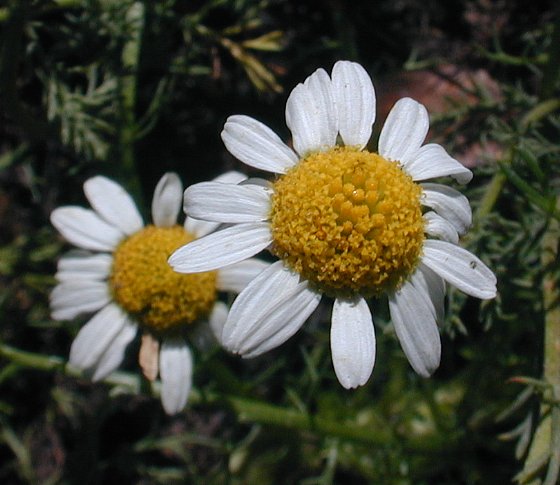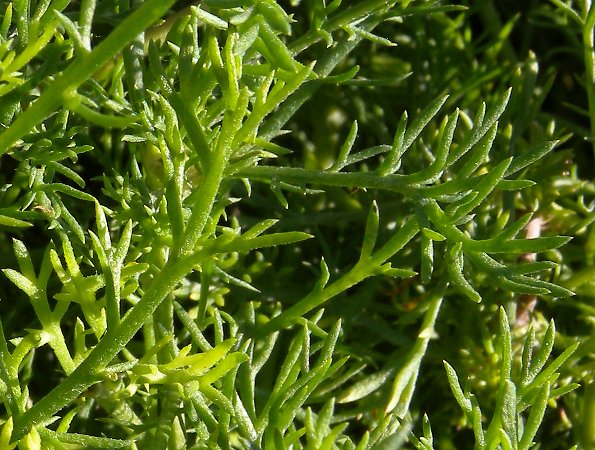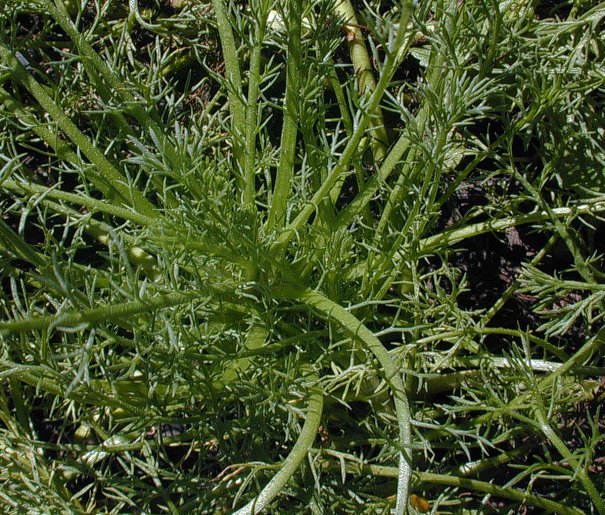
The corollas of the disk florets are 2-3 mm. long, narrowly tubular in shape, and yellow; they have 5 spreading lobes at their apices. Between the corollas of the disk florets, there are chaffy scales; these scales are white-membranous along their margins and oblong in shape with rounded erose (somewhat frayed) tips. Around the base of each flowerhead, there are phyllaries (floral bracts) in several overlapping and appressed series that together form a shallow saucer-like shape. The phyllaries are lanceolate-oblong with blunt tips, light green with white-membranous margins, and more or less covered with short white-woolly hairs. The blooming period occurs during the summer and early autumn for 1½–3 months. Afterwards, fertile florets are replaced by small achenes about 1–1.5 mm. long. These achenes are oblongoid in shape, pale-colored, and slightly flattened or 3-angled; each achene has 3 filiform ribs on one side. The root system is fibrous, rhizomatous, and relatively shallow. This plant can spread by reseeding itself or by forming clonal offsets from the short rhizomes.
Cultivation: The preference is full or partial sun, moist to mesic conditions, and soil consisting of either loam or sandy loam. This plant is easy to cultivate and it occasionally spreads into adjacent areas.

Range & Habitat: Roman Chamomile has rarely naturalized in Illinois and thus far wild populations have been reported from only a few counties (see Distribution Map). Roman Chamomile is native to western Europe and it was introduced into North America as an ornamental and herbal plant for gardens. In North America, naturalized populations of this plant are found primarily in urban areas, including such habitats as areas near gardens, lawns, grassy roadsides, vacant lots, and construction sites. In Europe, it has been found in such habitats as grassy roadsides, sandy lawns in commons areas, and sandy pastures. Roman Chamomile is still cultivated in flower and herbal gardens, from where it occasionally escapes, but rarely persists. Areas with a history of disturbance are preferred.
Faunal Associations: The nectar and pollen of the flowerheads probably attract small bees and various flies; wasps and beetles may visit the flowerheads to a lesser extent. Two aphids, Macrosiphoniella tanacetaria and Macrosiphoniella tapuskae, are known to feed on Roman Chamomile (Blackman & Eastop, 2013). A polyphagous leafhopper, Empoasca erigeron, also feeds on this plant (Dmitriev & Dietrich, 2010). At the present time, information about this plant's relationships with granivorous birds and herbivorous mammals is unavailable.

Photographic Location: An ornamental garden at the Urbana Public Library of Urbana, Illinois.
Comments: There are several species of plants in the Aster family that have daisy-like flowerheads with white petaloid rays. Many of these species have been introduced into North America from Eurasia as garden plants, including Roman Chamomile (Chamaemelum nobile). Roman Chamomile can be distinguished from most of these species by its highly fragrant foliage and crushed flowerheads, which have an apple-pineapple scent. One other species in this group that has naturalized in Illinois, German Chamomile (Matricaria chamomile), also has foliage and crushed flowerheads with a similar fruity scent. German Chamomile can be readily distinguished by its glabrous foliage, more erect habit, the hollow interior of its flowerheads, and the lack of chaffy scales between the disk florets. This latter plant is also an annual, rather than a perennial. Both of these species have been used as ingredients in Chamomile tea, and the chemical constituents of their flowerheads are said to have relaxing and soothing properties. An alternative scientific name for Roman Chamomile is Anthemis nobilis, and it has other common names, including Low Chamomile, English Chamomile, and Garden Chamomile.